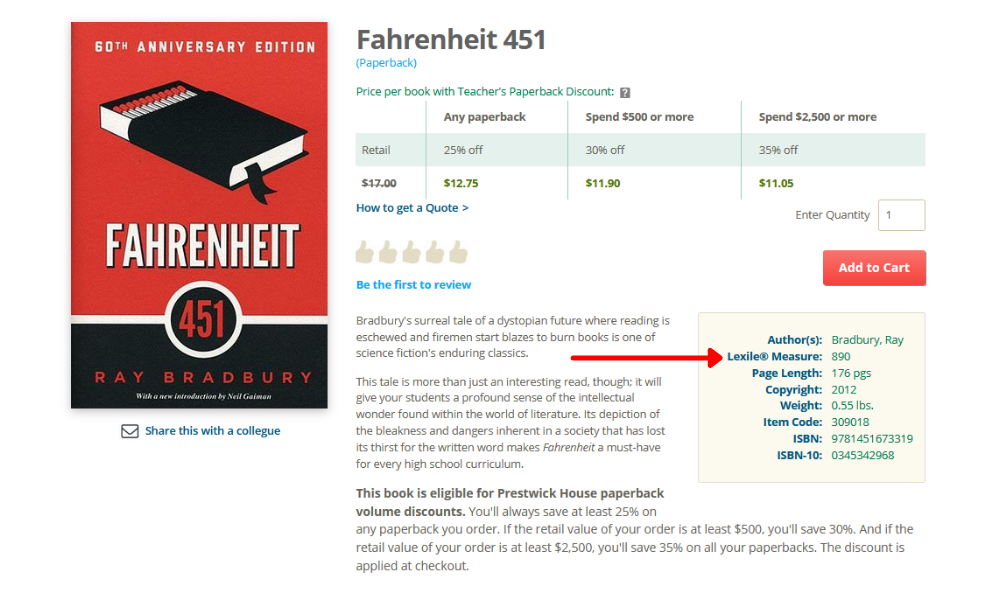Lexile measures can be great tools for deciding which books you should teach in your classroom, and they can help you guide your students to books they might want to read at their leisure.
Let’s take a look at what Lexile measures are and how you can use them to determine which books are best to share with your students.
What is a Lexile Measure?
Created by educational research company MetaMetrics, “Lexile measure” refers to one of two things: a text’s difficulty or a reader’s proficiency. Lexile measures are represented as a series of numbers followed by an L (e.g., 1080L). The higher the number, the more difficult the text or the more proficient the reader.
Text Measures
When applied to a text, Lexile measures tell you how difficult the text is. They cannot tell you whether the text contains meaningful, valuable, or age-appropriate content; the Lexile measure is strictly a measure of readability.
Some books with low Lexile measures contain challenging ideas that are tough to understand, and vice-versa. Just because a text uses easy words doesn’t mean that your students will understand the ideas the text presents.
Reader Measures
Applied to a reader, Lexile measures are a bit more complicated.
First, student measures are usually determined by scores on end-of-year reading assessments. Not all states report Lexile measures from these assessments. You can see if your state is part of the program here.
Second, if a student’s Lexile measure exactly matches that of the text, that student can be expected to comprehend approximately 75% of the text.
As a student’s Lexile measure increases, the percentage of the text the student can be expected to comprehend increases as well. However, this increase is not on a linear scale; with an increase of 250L, the student can be expected to comprehend 90% of a text (a gain of 15 percentage points). With an increase of an additional 250L, the student can be expected to comprehend 96% of a text (a gain of only 6 additional percentage points).
As a student’s Lexile measure decreases, however, comprehension drops off quickly. Each decrease of 250L chops 25 percentage points off the expected comprehension rate.
For this reason, it’s inadvisable to assign students texts with Lexile measures very far above their personal measures. The best practice is to assign texts no higher than 50L above a student’s personal measure.
One more thing about reader measures: If a student’s personal measure is below 0L, the designation “BR” is added. BR stands for “Beginning Reader.” The closer this number is to 0, the more advanced the reader’s skills are. A reader with a score of BR75L is a more proficient reader than one with a score of BR160L, for example.
Finding a Book’s Lexile Measure
There’s no need to scour the internet trying to find a book’s Lexile measure! MetaMetrics has simplified the search, thanks to its free database. Here, you can look up books by title, author, ISBN number, or keyword. You can also do a broader search by grade level or Lexile measure range to discover recommended books for those categories. Keep in mind, not all published books have an assigned Lexile measure.
At Prestwick House, we make it easy to find a book’s Lexile measure when browsing our site. Most of our listings for paperbacks and hardcover books display the book’s measure, as determined by MetaMetrics. Just look to the sidebar under each listing on the right side of the page to find it!

Want more information? Get in touch!
If you have questions about Lexile measures that aren’t answered in this post, email our curriculum team at info@prestwickhouse.com, and we’ll find the answers. Be sure to put “Lexile” in the subject line so we can reply to your message!
METAMETRICS®, the METAMETRICS® logo and tagline, LEXILE®, LEXILE® FRAMEWORK, LEXILE® ANALYZER and the LEXILE® logo are trademarks of MetaMetrics, Inc., and are registered in the United States and abroad. The trademarks and names of other companies and products mentioned herein are the property of their respective owners. Copyright © MetaMetrics, Inc. All rights reserved.